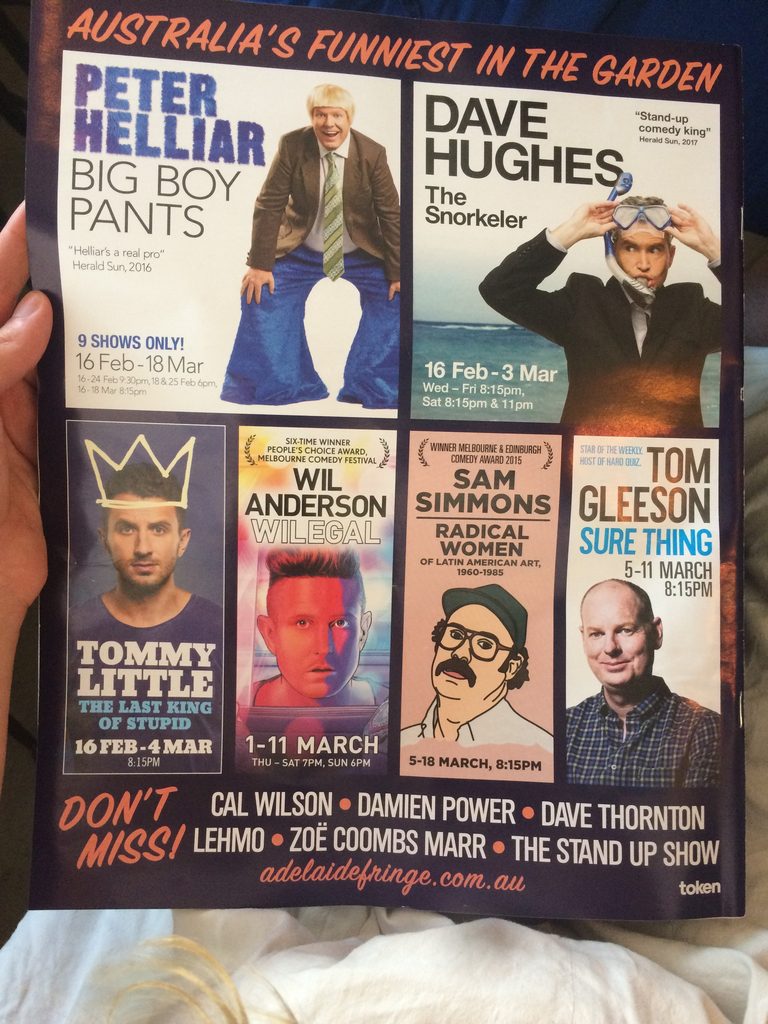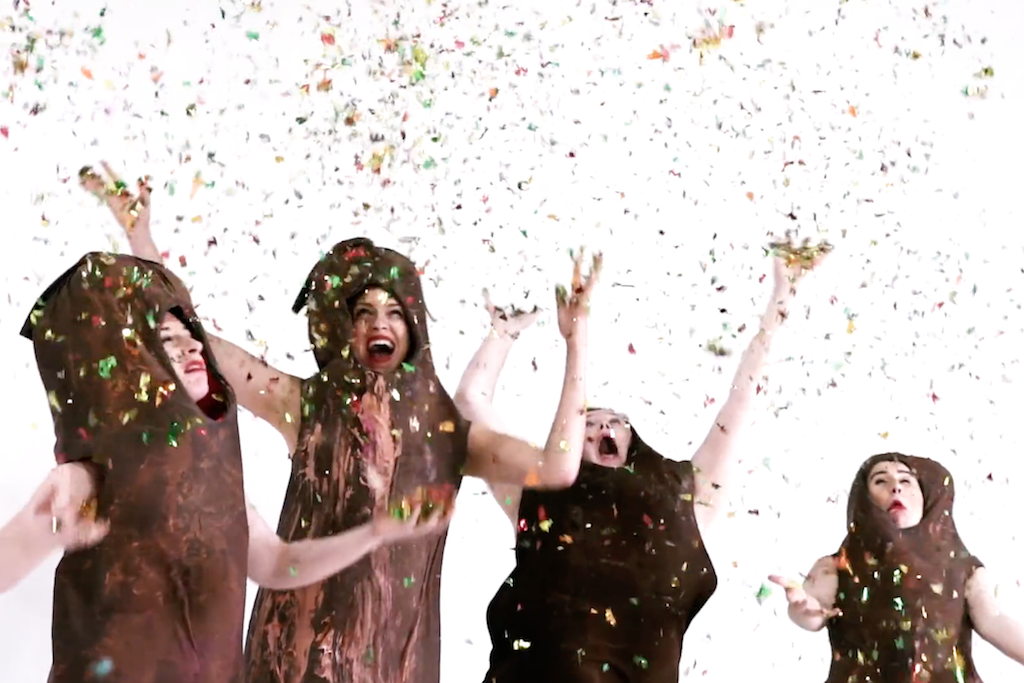It’s Time For Australian Comedy To Move Beyond The Boys Club
There's a revolution happening overseas but in Australia, straight white men still dominate the comedy circuit.

Do you need to be a dude to make it in the Australian comedy industry? It’s a question I ask myself a lot at this time of year.
Our annual comedy season began in February at the Adelaide Fringe. From there, Australia’s professionally funny will pack their bags and roll onto Brisbane Comedy Festival, Canberra Comedy Festival and Melbourne International Comedy Festival, before ending at Sydney Comedy Festival in May. Some gluttons for punishment might even throw in one or two nights at Perth Fringe for good measure — either which way, the top of the year is a hell of a time for comedians.
This time of year also serves to remind that straight white men still dominate Australian comedy. You only need to pick up a copy of Adelaide’s street press to see what type of shows festivals tend to advertise:

Or you could open Instagram. To celebrate International Women’s Day last week, Brisbane Comedy Festival celebrated with a picture of Marge Simpson sitting on the couch wearing an open white shirt, revealing her (way-too-pert-to-have-breast-fed-three-kids) boobs, legs splayed in Y-fronts and surrounded by empty beer cans. Queer comedy outfit PO PO MO CO weren’t the only ones who questioned whether it was a “pro woman image”.
So why is Australia’s comedy scene so weighted towards the blokes?
A Little Bit Of Comedy Herstory
I was shot into the centre of the Melbourne Comedy scene very quickly. In a couple years, I moved from playing underground squats in Sydney’s Western Suburbs to a breakthrough Melbourne Fringe season and onto the books of Token, arguably the biggest comedy agency in the country. By 2004, I was the only token with Token (my favourite gag at the time).
The Aussie comedy scene was very different then to what it is today. Well, sort of. There were a lot less queers and men of colour killing it back then. There was no YouTube, no Twitter and no Facebook. International comics ruled the roost and there were at least ten white men to one female booked from Edinburgh or Montreal. It was slim pickings if you were after anything that wasn’t heteronormative in approach, even though a lot of Aussie male comics had Lesbian haircuts (Wil Anderson and Josh Earl, I’m looking at you).
One thing that hasn’t changed is the lack of women — and in particular women of colour — in comedy programs. Of the 67 headline shows at this year’s Brisbane Comedy Festival, for instance, only 18 are from women. I don’t believe that any of them are women of colour.
Men used to be the ones who won all the awards and pulled the big crowds. Comedy’s a notoriously hard gig, especially when it comes to paying your bills. But sitting out the back of Hairy Little Sister in Melbourne’s CBD around four years back, I heard Tom Gleeson call Melbourne International Comedy Festival a “sweep-up” because of how easy he found it to make money doing shows at the festival.
Jokes at the expense of women, folks with disabilities, lesbians, “Asians”, fat people (mainly fat women), Muslims and indigenous people have dominated rooms for decades. Sexual harassment was a tenant of every late night gig, toxic masculinity and power play was rife. One can only imagine the men who thrived in this period having a slightly nervous run in 2018 as the #MeToo movement takes out one sexual predator at a time.
Nowadays, my white-norm brothers still have the numbers and headline positions, but outliers have been snatching some of the top honours — Hannah Gadsby, Rhys Nicholson, Tom Ballard and Zoe Combs-Marr are the foremothers of the new Queerdom in Comedy. Not that any of them are new, and all have done the hard yards to get where they are.
Interestingly enough, Gadsby’s award-winning work Nanette and Combs-Marr’s Trigger Warning both hold a light (albeit in very different ways) to the extraordinary misogyny and homophobia embedded in the comedy world. Both shows give highly sophisticated and nuanced commentary on an industry with a history of cutting off oxygen to any one who isn’t a cis-gendered heterosexual white man.
Comedy Is Coded
Comedy is a gruelling craft and stand-up is particularly difficult. One person, one microphone, one (hopefully sturdy) microphone stand, perhaps a stool with a glass of water on it and, of course, the audience.
In my experience the relationship with the audience is as — if not more — important than the material. I’ve seen beautifully constructed jokes fall flat, and poorly written side notes unleash riotous laughter and applause. Whether dark or whimsical or political or physical, the charisma and character of a comedian mixed with timing, talent and a real knack for reading the room makes for a delightful night of entertainment.
Pleasing white audiences is a largely unconscious act for majority of Australian comedians. Most straight white men don’t even have to try. Many just think they’re just being funny, and they have had the privilege of just being human — the default and the dominant. Given that most comedy tours are self-funded and pushing something familiar is usually the most marketable and the easiest sell, straight white male comics are at a serious financial advantage. Risk taking is bad for the box office.
“I questioned myself: were straight white men funnier than everyone else, or was it the environment?”
Some comedians who are not white have struggled with this dynamic while others slid easily into the scene. I see-sawed between the two states. As a kid I used comedy to avert racism and show I had more to offer. Making white people laugh gave me currency and a safer passage most of the time.
When I stopped being so accessible and started seeking equality, things got grizzly. I questioned myself: was feminism a decidedly unfunny position, or was it the environment? Were straight white men funnier than everyone else, or was it the environment? Were straight white male comedians able to succeed because as a demographic they were more capable, or was it the environment?
To quote the ultimate straight white male comedian, Zoe Combs Marr’s alter-ego Dave: “I mean you can’t make intersectional feminism funny. It’s just not funny.”
The Movement
There is a global intersectional feminist movement rocking culture and usurping old kings right now. White boys around the world are learning that the age of entitlement is over. Abusers are being taken down and calls for greater representation in the arts are getting louder.
In the past two years, the most successful shows at Edinburgh Fringe Festival have been created by people (mainly women) of colour that defy the white male gaze and rage against the patriarchy. At home, some of Australia’s best comedians are female.
The revolution is very much in motion. Maybe 2018 can be the year the Australian comedy scene opens its invitation.
—
Candy Bowers is a writer, actor, comedian, filmmaker and contributor on ABC Comedy’s Tonightly with Tom Ballard. She is the original creator of Hot Brown Honey, which is in season at WOW Festival (Brisbane) in April and Southbank Centre (London) in July.
